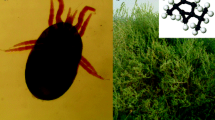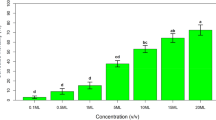Abstract
Pest management by conventional pesticides has become progressively hindered by developing pest resistance and increase in consumers demand for safe and residue-free foodstuffs. This will create a considerable market opportunity for alternative products, including botanical pesticides. The present study was conducted to assess the combination of carvacrol and thymol, their repellent activity, and residual toxicity against Dermanyssus gallinae with the aim of designing a new strategy relying on natural compounds for the control of D. gallinae. Different ratios of carvacrol-thymol, 5:0, 4:1, 3:2, 2:3, 1:4, and 0:5 based on LD50 values, were tested for their toxicity on D. gallinae. For residual toxicity assay, mortality rate of mites recorded after being exposed to the surfaces 1, 3, 7, 14, 21, and 28 days post spraying by carvacrol-thymol preparation. In combination toxicity, carvacrol-thymol in 4:1 ratio showed the highest efficacy against D. gallinae. The highest repellent activity was observed in carvacrol-thymol 5:0 combination. Addition of thymol to carvacrol resulted in a decrease in repellent activity of carvacrol as was seen in carvacrol-thymol 3:2, 2:3, and 1:4 ratios (p < 0.05). Carvacrol-thymol in 4:1 ratio at 2 % concentration displayed good residual toxicity and was effective against D. gallinae till 14 days post spraying (p < 0.05). The present study showed that the combination of carvacrol-thymol particularly with a 4:1 ratio displayed improved acaricidal activity and good residual toxicity. However, combining the application of carvacrol and thymol did not show any synergistic effect on repellent activity. Overall, carvacrol-thymol can be suggested as an alternative strategy for the control of D. gallinae.

Similar content being viewed by others
References
Abdel-Ghaffar F, Sobhy HM, Al-Quraishy S, Semmler M (2008) Field study on the efficacy of an extract of neem seed (Mite-Stop®) against the red mite Dermanyssus gallinae naturally infecting poultry in Egypt. Parasitol Res 103(3):481–485
Abdel-Ghaffar F, Semmler M, Al-Rasheid K, Mehlhorn H (2009) In vitro efficacy of byeMite® and mite-stop® on developmental stages of the red chicken mite Dermanyssus gallinae. Parasitol Res 105(5):1469–1471
Ahn YJ, Lee SB, Lee HS, Kim GH (1998) Insecticidal and acaricidal activity of carvacrol and β-thujaplicine derived from Thujopsis dolabrata var. hondai sawdust. J Chem Ecol 24:81–90
Barimani A, Youssefi MR, Tabari MA (2016) Traps containing carvacrol, a biological approach for the control of Dermanyssus gallinae. Parasitol Res doi:10.1007/s00436-016-5113-3
Chauve C (1998) The poultry red mite Dermanyssus gallinae (De Geer, 1778): current situation and future prospects for control. Vet Parasitol 79:39–45
Chikuba T, Itou H, Sakakibara H, Inoue D (2008) Detection of fowl pox virus from red mite (Dermanyssus gallinae) at a layer farm occurring cutaneous fowlpox. J Jpn Soc Poult Dis 44:113–117
Chirico J, Eriksson H, Fossum O, Jansson D (2003) The poultry red mite, Dermanyssus gallinae, a potential vector of Erysipelothrix rhusiopathiae causing erysipelas in hens. Med Vet Entomol 17:232–234
Di Campli E, Di Bartolomeo S, Pizzi PD, Di Giulio M, Grande R, Nostro A, Cellini L (2012) Activity of tea tree oil and nerolidol alone or in combination against Pediculus capitis (head lice) and its eggs. Parasitol Res 111(5):1985–1992
George DR, Callaghan K, Guy JH, Sparagano OAE (2008) Lack of prolonged activity of lavender essential oils as acaricides against the poultry red mite (Dermanyssusgallinae) under laboratory conditions. Res Vet Sci 85(3):540–542
George DR, Sparagano OAE, Port G, Okello E, Shiel RS, Guy JH (2009) Repellence of plant essential oils to Dermanyssus gallinae and toxicity to the non-target invertebrate Tenebrio molitor. Vet Parasitol 162(1):129–134
George DR, Olatunji G, Guy JH, Sparagano OAE (2010) Effect of plant essential oils as acaricides against the poultry red mite, Dermanyssus gallinae, with special focus on exposure time. Vet Parasitol 169(1):222–225
Govindarajan M, Rajeswary M, Arivoli S, Tennyson S, Benelli G (2016). Larvicidal and repellent potential of Zingiber nimmonii (J. Graham) Dalzell (Zingiberaceae) essential oil: an eco-friendly tool against malaria, dengue, and lymphatic filariasis mosquito vectors? Parasitol Res 115(5):1807-1816
Govindarajan M, Rajeswary M, Hoti SL, Bhattacharyya A, Benelli G (2016b) Eugenol, α-pinene and β-caryophyllene from Plectranthus barbatus essential oil as eco-friendly larvicides against malaria, dengue and Japanese encephalitis mosquito vectors. Parasitol Res 115(2):807–815
Hamidi A, Sherifi K, Muji S, Behluli B, Latifi F, Robaj A, Postoli R, Hess C, Hess M, Sparagano OAE (2011) Dermanyssus gallinae in layer farms in Kosovo: a high risk for Salmonella prevalence. Parasit Vectors 4:136
Jayakumar S, Madankumar A, Asokkumar S, Raghunandhakumar S, Gokula Dhas K, Kamaraj S, Divya MG, Devaki T (2012) Potential preventive effect of carvacrol against diethylnitrosamine-induced hepatocellular carcinoma in rats. Mol Cell Biochem 360:51–60
Kirkwood AC (1968) Anemia in poultry infested with red mite Dermanyssus gallinae. Vet Rec 80:514–516
Kim S, Yi J, Tak J, Ahn Y (2004) Acaricidal activity of plant essential oils against Dermanyssus gallinae (Acari: Dermanyssidae). Vet Parasitol 120:297–304
Ma WB, Feng JT, Jiang ZL, Wu H, Ma ZQ, Zhang X (2014) Fumigant activity of eleven essential oil compounds and their selected binary mixtures against Culex pipiens pallens (Diptera: Culicidae). Parasitol Res 113(10):3631–3637
Mehlhorn H, Schmahl G, Schmidt J (2005) Extract of the seeds of the plant Vitex agnus castus proven to be highly efficacious as a repellent against ticks, fleas, mosquitoes and biting flies. Parasitol Res 95(5):363–365
Mehlhorn H (2016). Available means to control bloodsucking ticks, mites and insects—an overview. In Nanoparticles in the Fight against Parasites (pp. 37–45). Springer International Publishing.
Miresmailli S, Bradbury R, Isman MB (2006) Comparative toxicity of Rosmarinus officinalis L. essential oil and blends of its major constituents against Tetranychus urticae Koch (Acari: Tetranychidae) on two different host plants. Pest Manag Sci 62:366–371
Novato TPL, Araújo LX, de Monteiro CMO, Maturano R, Senra TDOS et al (2015) Evaluation of the combined effect of thymol, carvacrol and (E)-cinnamaldehyde on Amblyomma sculptum (Acari: Ixodidae) and Dermacentor nitens (Acari: Ixodidae) larvae. Vet parasitol 212(3):331–335
Pastor J, García M, Steinbauer S, Setzer WN, Scull R, Gille L, Monzote L (2015) Combinations of ascaridole, carvacrol, and caryophyllene oxide against Leishmania. Acta Trop 145:31–38
Schmahl G, Al-Rasheid KA, Abdel-Ghaffar F, Klimpel S, Mehlhorn H (2010) The efficacy of neem seed extracts (Tre-san®, Mitestop®) on a broad spectrum of pests and parasites. Parasit Res 107(2):261–269
Semmler M, Abdel-Ghaffar F, Al-Rasheid K, Mehlhorn H (2009) Nature helps: from research to products against blood-sucking arthropods. Parasitol Res 105(6):1483–1487
Sparagano O, Pavlicevic A, Murano T, Camarda A, Sahibi H, Kilpinen O, Mul M, van Emous R, le Bouquin S, Hoel K, Cafiero MA (2009) Prevalence and key figures for the poultry red mite Dermanyssus gallinae infections in poultry farm systems. Exp Appl Acarol 48:3–10
Tabari MA, Youssefi MR, Barimani A, Araghi A (2015) Carvacrol as a potent natural acaricide against Dermanyssus gallinae. Parasitol Res 114(10):3801–3806
van Emous R (2005) Wage war against the red mite. Poultry Int 44:26–33
Wang FF, Wang M, Xu FR, Liang DM, Pan BL (2010) Survey of prevalence and control of ectoparasites in caged poultry in China. Vet Rec 167:934–37
Author information
Authors and Affiliations
Corresponding author
Rights and permissions
About this article
Cite this article
Masoumi, F., Youssefi, M.R. & Tabari, M.A. Combination of carvacrol and thymol against the poultry red mite (Dermanyssus gallinae). Parasitol Res 115, 4239–4243 (2016). https://doi.org/10.1007/s00436-016-5201-4
Received:
Accepted:
Published:
Issue Date:
DOI: https://doi.org/10.1007/s00436-016-5201-4




